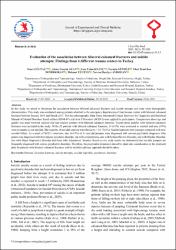Evaluation of the association between bilateral calcaneal fractures and suicide attempts: Findings from 4 different trauma centers in Turkey

View/
Date
2021Author
Gültaç, EmreAçan, Ahmet Emrah
Kılınç, Cem Yalın
Gündüz, Nermin
Emirkıran, Nihat Demirhan
Yücens, Mehmet
Aydoğan, Nevres Hürriyet
Metadata
Show full item recordCitation
Gültaç E, Acan AE, Kilinç CY, Gündüz N, Emirkiran ND, Yücens M, Aydoğan NH. Evaluation of the association between bilateral calcaneal fractures and suicide attempts: Findings from 4 different trauma centers in turkey. J Exp Clin Med [Internet]. 2021;38(3):221-6.Abstract
In this study we aimed to determine the association between bilateral calcaneal fractures and suicide attempt and some socio-demographic characteristics. This study was conducted among patients admitted to the emergency departments of four trauma centers with bilateral calcaneal fractures between January 2014 and March 2017. The Sociodemographic Data Form, Structured Clinical Interview for Diagnostic and Statistical Manual of Mental Disorders fourth edition (DSM-IV) and Axis I Disorders (SCID-I) were applied to participants. Comparisons about age and gender was made between suicidal and non-suicidal patients with bilateral calcaneal fractures. Twenty-three patients with bilateral calcaneus fractures were included in the study. Of the 23 patients with bilateral calcaneal fractures, 14 (61%) were evaluated as suicidal and nine (39%) were evaluated as not suicidal. The majority of suicidal jumpers were female (n = 11, 78.6%). Suicidal patients were younger compared with non-suicidal fallers. As a result of SCID I interview, nine (64.3%) of 14 suicidal jumpers were diagnosed with serious psychiatric diagnoses: One patient was diagnosed with first episode psychotic disorder, one with schizophrenia, one with Schizoaffective Disorder, one with Bipolar Disorder, two with Major Depressive Disorder and three with Adjustment Disorder. Based on our study results we determined that suicidal jumpers are frequently diagnosed with serious psychiatric disorders. Therefore, the psychiatric dimension should be taken into consideration in the treatment plan for patients with bilateral calcaneal fractures and the multidisciplinary approach should be taken.

















